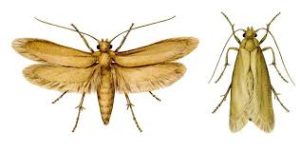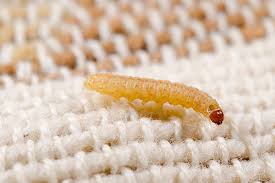Clothes moths certainly have a good taste. Your expensive cashmere and silk are what they love to eat. Their presence can, therefore, prove to be very destructive for your wardrobe. They feed on the keratin protein found in natural fibers such as wool, silk, fur, feather, etc. Unfortunately, the adults do not cause any damage to your clothing. It is the larvae that eat away the fibers, creating holes in your expensive garment. If you spot the adult moths, be ready to deal with severe infestation.
Thankfully, clothes moth control is easy and effective. In most cases, good housekeeping practices are enough to deal with mild to moderate infestation. Here are some helpful tips to handle clothes moth infestation:
Monitoring and Prevention
- Inspect your clothes regularly, especially the ones that you have kept in your closet, drawers, etc. If you leave your clothing in dark, undisturbed places for a long time, they become prone to clothes moth infestation. Take out all items at least once in a year on a bright, sunny day and hang them in the sun. Clothes moths do not like light and when exposed to bright light, they will fall down.
- Vacuum closets and drawers thoroughly to remove any larvae or adults that may still be hiding in the crevices. Even if there is no
 infestation, you should still vacuum the drawers, closets, rugs, pet bedding, upholstered furniture, and carpets to keep them clean.
infestation, you should still vacuum the drawers, closets, rugs, pet bedding, upholstered furniture, and carpets to keep them clean. - Inspect the clothes to look for signs of damage in the hidden parts of clothes such as collars, inside of pockets, etc. Check the fabric to see if it has an uneven surface or holes. With fur, look for loose hairs and exposed areas. If you find any sign of damage or infestation, follow the steps mentioned below.
- Before storing clothes, get them dry cleaned or laundered. Do not store dirty clothes, as moths are attracted to human sweat, body oil, and food particles.
- Clothing should be stored in tight-fitting containers. You can wrap them in large plastic bags along with some naphthalene balls or flakes containing paradichlorobenzene. The vapors from these materials can kill the clothes moth adults as well as the larvae. But, the vapors must be present in a specific concentration. In order to achieve this, you must put the recommended quantity of mothballs.
Clothes Moth Control
- If you notice any signs of infestation, hang the clothing, rugs carpets, etc. in the sun and brush them. Brushing helps in removing the larvae and the eggs.
- Get the infested items dry cleaned or laundered before putting them back.
- Clean the closet or storage area thoroughly. Vacuum it and wash it with warm water, if possible. All cracks and crevices should be cleaned thoroughly to remove the larvae and the eggs.
- Before returning the cleaned clothes, dust the closet and the drawers with pyrethroids or pyrethrin. These insecticides should be easily available with your nearby pest control shop. Apply them in cracks and crevices as well.
- Heat or cold treatment is another effective clothes moth control Heat the infested items in an oven for 30 minutes at 120 degrees Fahrenheit or wrap them in a plastic bag and put them in the freezer for a few days. You may fumigate the clothes with dry ice. This will kill the eggs, larvae, and the adults. This process may not be suitable for all forms of clothing, as the heat or cold may damage the fabric.
- Pheromone traps are a relatively easy method of controlling clothes moth infestation. These traps have a sticky upper side and they contain pheromone, a chemical that insects release into the environment to attract other insects for mating. It is also known as sex hormone. The male moths will get lean toward the pheromone and will get stuck on the sticky surface. Once the males get trapped, you can remove them and place fresh traps until all the males have been caught. By eliminating males, you will be able to restrict mating and the chances of occurrence of next generation.
- If the infestation is severe, you may spray the clothing or carpet with pyrethrin based insecticide. Make sure you use the insecticide that is exclusively meant for clothes moths and always follow the instructions mentioned on the label.
Using insecticide on your own can be risky, especially when you are using it on your carpet, wool rugs, fur, or on any expensive clothing. Some insecticides are oil based and they are not suitable for silk, rayon and other fabric that stain easily. To avoid any form of damage to your belongings, you must seek the help of a nearby pest control company.


No Comments